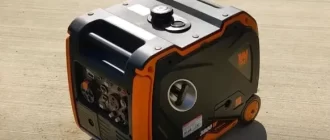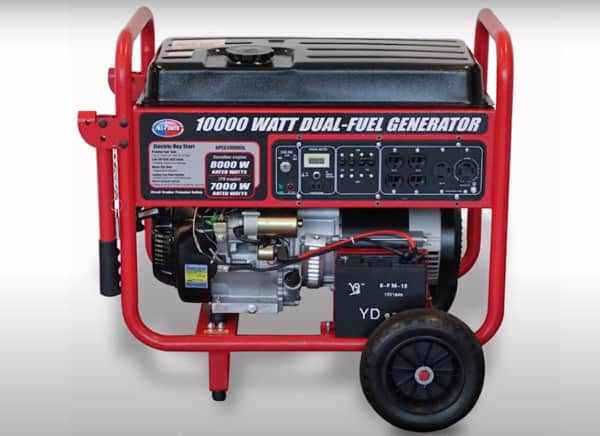More and more people are thinking about buying a backup (emergency) generator for their home, not only because of natural disasters, but also because of the danger of war.
When does the purchase make sense? An emergency generator is a small combined device consisting of an engine and a generator. With its help, electrical power can be generated by fuel. Its application possibilities are various and go far beyond the supply of electrical energy in emergencies. Read in this text everything you need to know about the power generator in the family house.
See also: Best Backup Generators for Home in 2024
Components of a power generator
A genset consists of a small gasoline engine and a connected generator. Sometimes a small gearbox is also built into the generator to generate higher speeds. The range of power generators extends from small, portable gensets to power generators mounted on trailers or delivered by container. These large power plants are then also technically somewhat more complex. They are usually equipped with water cooling.
Types of generators
Generators differ in the way they are driven and in the way they deliver the generated electricity.
The engine types for power generators are:
- Two-stroke engine
- four-stroke engine with gasoline drive
- Four-stroke engine with gas drive
- Four-stroke engine with diesel drive
Two-stroke gensets are offered more and more rarely. To date, they are mainly intended for very small power generators. These are portable and can provide light or run small electrical appliances when needed. Their power is severely limited and they are not durable. When operating them, care must be taken to mix fuel with oil in the correct ratio. This is also the problem with two-stroke gensets: they are extremely noisy and produce very harmful exhaust gases.
Four-stroke gasoline-powered gensets are the most common types of generators. They are powered by small to medium-sized small power plants. Gasoline gensets, provided they are of a reasonable brand quality, are quite stable. They can also be used to generate electricity on a decentralized basis over a longer period of time.
Four-stroke gas-powered gensets are virtually identical to their gasoline counterparts. They are just much more economical and produce less toxic exhaust gases.
Diesel-powered generators are reserved mainly for large power classes. They can be used to permanently power heavy equipment, many consumers or applications in the 400-volt range. They are quite expensive and only suitable as an emergency generator for a single-family home under certain circumstances.
In addition to size and drive type, gensets also differ in the quality of their power output. Sensitive devices sometimes require a particularly stable power supply with a constant voltage. For this purpose, the “inverter” power unit is best suited. These devices are ideal for the operation of computer equipment.
Good to know: Best Portable Generator for Home Use
Why do you need an emergency generator for your house?
The power supply in Europe is largely secured throughout the country. Power outages are very rare. Investing in an expensive device just for this case is actually unnecessary. However, there are good reasons for a separate power generator for hobby purposes. These mini power plants offer
- Decentralized power supply
- Provision of high voltages
- Connection of many consumers with high power consumption
Depending on the size of the property, a decentralized power supply can make sense. If it is extremely spread out and you want to have a power supply even at the very tip, a long extension cable is not useful.
If you couple too many cable drums in a row, the line resistance can overwhelm the house fuse. As a rule, either the fuses or the RCD will then trip continuously. But if you are unlucky, you risk a cable fire.
The same applies if you want to connect devices to the house network for which it is not actually designed. Welding equipment or metalworking machines such as milling machines or lathes usually require a 400 volt connection.
There are transformers that can convert the 110 volt house current to the desired voltage. However, this is also not recommended.
Unless an electrician-approved 400 volt power supply is connected in the house or garage, only the emergency generator can produce the desired power. However, the generator should also be sized accordingly.
But even if normal devices with 110 volt operation are connected to the house network in too large a number, this can overload the existing installation. This application occurs, for example, during construction work: If a garage is to be added to a single-family house, many tools are required.
If a caulking hammer, circular saw, concrete mixer and floodlight are then operated simultaneously via the house current, an overload will certainly occur again. Here, appropriately dimensioned power generators can also ensure the necessary operational safety.
Emergency generator at the single-family house – these possibilities exist
If, however, there is a real need to equip a home with an emergency generator, there are various options.
The simplest but also the most expensive option is to install a generator in a suitable place. Cellars or garages are the best places because of the space they offer.
An emergency generator should be connected to the house mains by a qualified electrician. The operation of this emergency power supply is only really useful if it starts automatically in the event of a power failure. This is the responsibility of the electrician.
Self-sufficient energy supply through combined heat and power units
However, there is a way to save buying your own emergency power generator by relying on a suitable regular power supply.
If you install a block-type thermal power station in your house, you already have all the advantages of an independent power supply on site. A combined heat and power unit is also basically nothing more than an energy generator.
It is a conventional generator driven by a diesel engine. The diesel engine is fired by the regular fuel oil. Its waste heat is used to heat the building – so even without an emergency generator in a family home, you have a reliable, permanent power supply.
Combined heat and power units are thus the ideal solution for remote houses such as those on islands or far from the power grid. But even a single-family home connected to the regular power grid can achieve significant savings in heating and electricity costs with a combined heat and power unit.
The chemically bound energy of the diesel or fuel oil is finally used twice and thus completely by the block-type thermal power station. This means that combined heat and power plants have a particularly high degree of efficiency.
Supplemented by good insulation and solar or wind power support, the need for public electricity can thus be reduced to almost zero. An emergency generator for the family home is no longer necessary.









